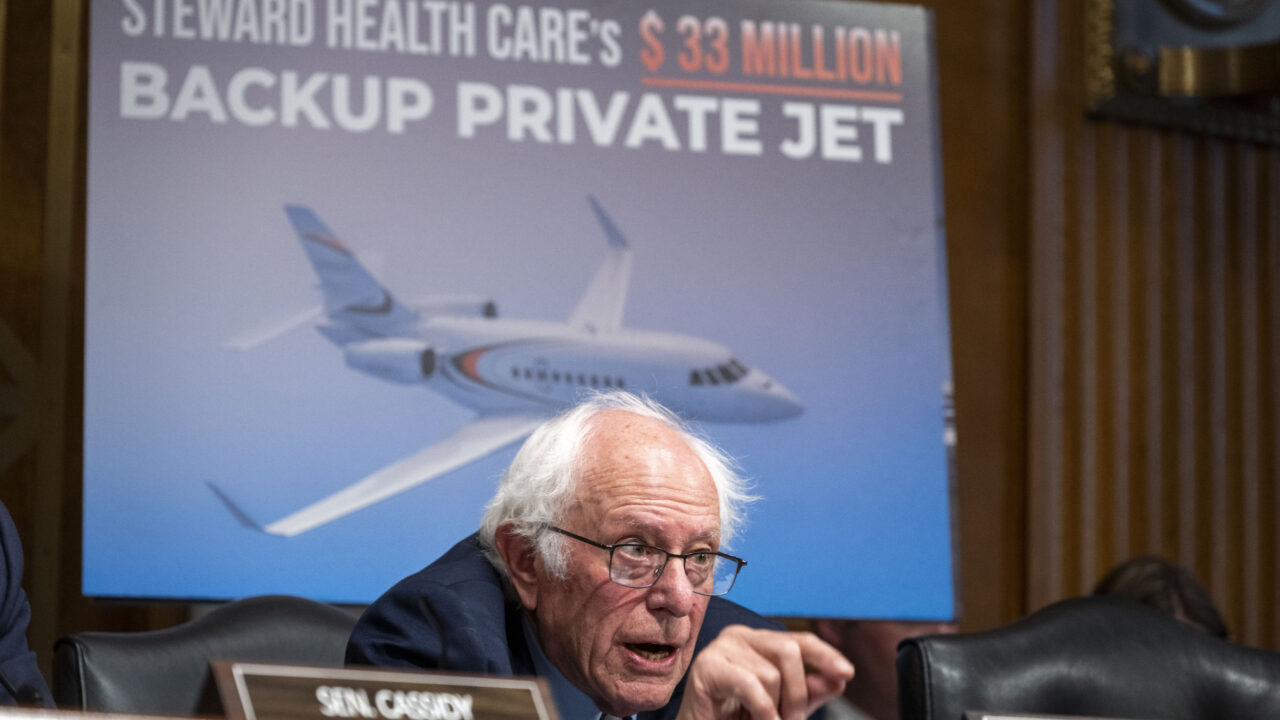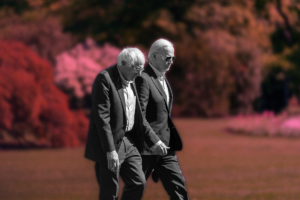Will the Real Populists Please Stand Up?
Trump’s billionaire oligarchy presents an opportunity for the left to reclaim populism. Sen. Bernie Sanders, I-Vt. (AP Photo/Kevin Wolf)
Sen. Bernie Sanders, I-Vt. (AP Photo/Kevin Wolf)
During a virtual town hall shortly before November’s presidential election, Elon Musk admitted that implementing the spending cuts he and his allies planned to propose during a second Trump administration would necessarily involve “some temporary hardship” for the American people. Unlike Donald Trump, who assured that “nobody” would feel the cuts, the Tesla CEO at least conceded that his austerity agenda would strike a financial blow to millions of Americans already struggling to make ends meet.
What the world’s richest man failed to mention was that his libertarian agenda would disproportionately hurt many of the voters who are essential to Trump’s tenuous electoral coalition. To even come close to achieving the drastic budget cuts that Musk and allies have touted, Republicans would have no choice but to slash funding for programs crucial to millions of Americans, including Medicare and Medicaid, SNAP and even Social Security. This would devastate lower-income communities that helped tilt the election in Trump’s favor, such as New Castle, Pennsylvania, which Trump became the first Republican to carry since Dwight Eisenhower in 1956. In New Castle, 1-in-4 residents live in poverty and depend on government programs like food stamps and disability benefits. As documented by the Washington Post, many of the city’s residents voted for the Republican candidate because they thought he would ease their financial burdens, not exacerbate them.
If the incoming president follows through on even a fraction of the $2 trillion in cuts that Musk and his allies have promised, the pain will be felt well beyond struggling small-town America. Veterans, especially, who voted overwhelmingly for the president-elect, could be in for a rude awakening. Shortly after being tapped to be Musk’s co-chair at the so-called Department of Government Efficiency, Vivek Ramaswamy posted on X that the first order of business should be to eliminate all spending on programs with expired authorizations from Congress, which amounts to over half a trillion dollars. Users were quick to point out that if Trump followed Ramaswamy’s advice, he would instantly defund health care for veterans, which is by far the largest spending program on that list.
It’s too soon to tell how far Trump will take the DOGE agenda. Already, rifts are forming in his unwieldy coalition as the traditional MAGA right and the techno-libertarians lock horns over issues like the H-1B visa program. Some on the right appear to grasp the potential pitfalls of Musk’s libertarian project, as it would almost certainly prove unpopular with voters. Those self-described populists, who claim Trump as their own, hope the president will sideline the Musk-led libertarian wing of the MAGA movement. But this is wishful thinking.
Trump 2.0 will be a government of, by and for the billionaire class.
While Trump has occasionally displayed populist impulses, his second term is shaping up to be more elitist than his most ardent supporters might like to admit. Beyond tapping the world’s richest man to lead a cost-cutting committee, the president-elect has assembled what will easily be the wealthiest Cabinet in history, with over a dozen billionaires set to work in the new administration. Other prominent billionaires, like venture capitalist Marc Andreessen, have been closely involved in the transition. Not surprisingly, some of the more populist officials from Trump’s first term, like trade chief Robert Lighthizer, have been effectively shut out this time around.
If the administration’s billionaires get their way — and it looks like they will — Trump 2.0 will be a government of, by and for the billionaire class. This triumph of the libertarian and corporate wings of the MAGA movement offers the latest proof that the GOP’s supposed transformation into a party of the working class is greatly exaggerated, if not complete fiction. At the same time, it provides the Democratic Party, which has been hemorrhaging working-class voters over the past decade, an opportunity to reclaim that title.
There is strong evidence showing that the most effective way to combat pseudo-populism on the right is with genuine economic populism on the left. Polling consistently reveals popular support for economic policies aimed at curbing corporate power and reducing today’s Gilded Age levels of inequality. While one of the first major policies on Trump’s agenda is to deliver another massive tax cut to corporations and billionaires, surveys almost always show that large majorities support raising taxes on both. And while voters expressed broad support for more regulation and oversight of industries like finance and tech, Trump and Musk have vowed to go on a deregulation spree, even proposing to eliminate entire agencies, like the Consumer Financial Protection Bureau, which is popular with voters but hated by fintech investors like Andreessen.
To its credit, the Biden administration has pushed through some genuinely populist reforms over the past four years. At the Federal Trade Commission, rising star Lina Khan has gone toe-to-toe with the likes of Amazon and Kroger, while general counsel Jennifer Abruzzo and her Democratic colleagues at the National Labor Relations Board have championed the rights of workers to form unions after decades of declining membership. Yet, Biden and Democrats have struggled to close the gap between public approval of these policies and a lack of public awareness, in part because of the president’s inability to effectively communicate with the American public.
Kamala Harris’ campaign further undermined these efforts when it shifted to the center in an effort to win over Wall Street and Silicon Valley. Instead of leaning into the Biden administration’s adversarial approach toward corporate power, Harris adopted a pro-business tone and refused to defend Khan when big donors publicly called for the trust-buster to be fired. This approach generated tremendous excitement among the donor class, who helped fill the campaign’s coffers with over $1 billion in a few months, but it dampened whatever initial enthusiasm voters felt for the candidate when she entered the race.
The most important takeaway from Harris’ loss to Trump is that the next Democratic majority will not emerge from a coalition of college-educated professionals and affluent suburbanites. To win future elections, Democrats must also win back working-class voters who have abandoned them in recent years.
Genuine populism poses a threat to Democrats’ political and financial interests.
The good news for Democrats is that the Trump administration will be easy to paint as a government of billionaire oligarchs waging a class war against working people. Confronting an administration full of modern-day robber barons, Democrats can craft an oppositional populist narrative. The bad news is that many powerful Democrats appear committed to preserving the status quo, because genuine populism poses a threat to their political and financial interests. Top Democrats are also understandably wary of alienating the party’s expanding base of affluent professionals, as well as its biggest and most prolific donors.
In a post on X shortly after the presidential election, Sen. Chris Murphy, D-Conn., called out Democrats for refusing to “pick big fights” — except, it seems, with left-populists trying to remake the party. When “progressives like Bernie [Sanders] aggressively go after the elites that hold people down, they are shunned as dangerous populists,” he wrote. This hostility toward populists might have something to do with the fact that “true economic populism is bad for our high-income base.”
Murphy is among a cohort of high-profile Democrats who hope to push their party into fully embracing economic populism, which they correctly see as the answer to Trumpism. The senator has circulated a memo on Capitol Hill arguing that Democrats must “reclaim our identity as the party of the working class” by talking about “why corporations and billionaires have too much.”
There are some hopeful developments in the race for leadership of the DNC as well. The current frontrunners, Ken Martin and Ben Wikler, both come from the midwestern populist tradition and seem committed to winning back working-class voters. Martin, who has led Minnesota’s Democratic-Farmer-Labor Party for more than a decade, released a memo this month calling for a “massive narrative and branding project” to improve the party’s image.
“The majority of Americans now believe the Republican Party best represents the interests of the working class and the poor, and the Democratic Party is the party of the wealthy and the elites,” wrote Martin. This, he said, is a “damning indictment on our party brand.”
The first step toward fixing the problem is accepting that there is a problem. But it’s also important to recognize that the Democrats don’t just have a branding problem; they have a politics problem. For years, liberals have clung to the idea that Trump and Trumpism can be defeated through the institutions; that the rising tide of fascism can be arrested by the courts or the bureaucracy. During this same period, Democratic leadership has repeatedly sabotaged and undermined the efforts of its own populist wing.
It should now be clear that Trumpism can only be defeated through politics, and that populism is the solution. As the second Trump administration inevitably descends into an orgy of oligarchic excess and callous cruelty, the populist script will practically write itself. The only question is whether the Democratic Party is ready to seize it.
Your support is crucial...As we navigate an uncertain 2025, with a new administration questioning press freedoms, the risks are clear: our ability to report freely is under threat.
Your tax-deductible donation enables us to dig deeper, delivering fearless investigative reporting and analysis that exposes the reality beneath the headlines — without compromise.
Now is the time to take action. Stand with our courageous journalists. Donate today to protect a free press, uphold democracy and uncover the stories that need to be told.






The idea that middle class people believe a group of billionaires will improve their situation is ludicrous. Americans are intelligent, honest, hardworking people and the problem with both political parties is candidates provided by both parties are not. The candidates invariably provide no real choice, so voting is like playing pin the tail on the donkey. And, this is because both parties represent the same entrenched wealth. It doesn't have to be this way. https://nevinhoraceoliphant.substack.com/p/our-constitutional-republic?r=3sr22y
The idea that middle class people believe a group of billionaires will improve their situation is ludicrous. Americans are intelligent, honest, hardworking people and the problem with both political parties is candidates provided by both parties are not. The candidates invariably provide no real choice, so voting is like playing pin the tail on the donkey. And, this is because both parties represent the same entrenched wealth. It doesn't have to be this way. https://nevinhoraceoliphant.substack.com/p/our-constitutional-republic?r=3sr22y